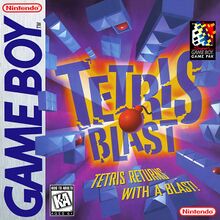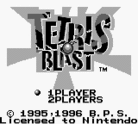Tetris Blast: Difference between revisions
*>Tepples →Game play: Where bombs are placed in pieces |
mNo edit summary |
||
| (17 intermediate revisions by 9 users not shown) | |||
| Line 1: | Line 1: | ||
{{Infobox |title = Tetris Blast | {{Infobox |title = Tetris Blast | ||
|developer = | |developer = [[Bullet-Proof Software]]<br />TOSE | ||
|publisher = Nintendo | |publisher = Nintendo | ||
|released = | |released = {{release|JP|March 17, 1995}}{{release|US|January 1, 1996}} | ||
|platform = | |platform = Game Boy | ||
|boxart = GB_Blast_Box_Front.jpg | |boxart = GB_Blast_Box_Front.jpg | ||
|title-scrn = GB_Blast_SS1.gif | |title-scrn = GB_Blast_SS1.gif | ||
| Line 10: | Line 10: | ||
|hard = no | |hard = no | ||
|preview = 1 to 4 depending on mode | |preview = 1 to 4 depending on mode | ||
|playfield = | |playfield = 10 × 17 | ||
| | |system = BPS rotation<br>([[SRS]] predecessor) | ||
}} | }} | ||
'''''Tetris Blast''''' is the | '''''Tetris Blast''''' (known as '''''Super Bombliss''''' in Japan) is the Game Boy port of ''[[Super Bombliss]]''. It features many unique ''Tetris'' modes mainly dealing with clearing the screen of all blocks by using bombs which were both given at the start as well as in the tetrominoes. In addition to the [[tetromino]]es of other ''Tetris'' games, ''Tetris Blast'' also uses dominoes and trominoes. | ||
The game was re-released as ''[[Super Bombliss DX]]'' in Japan in 1998, with a puzzle mode based on that of ''[[Super Bombliss]]''. | |||
== Game play == | == Game play == | ||
This version of [[Bombliss]] includes three modes of play. Training allows the player to set the gravity speed, and displays four pieces in the piece preview instead of one. | |||
In Contest, the player goes through stages with layouts of blocks, trying to clear the entire playfield to move on to the next stage. At the start of each stage, the player has 100 points. For each piece that enters the playfield, 1 point is lost. If the player runs out of points, the game ends. Creating explosions with large numbers of lines gives the player points back. When the playfield is empty, the remaining points are added to a total, and the next level starts. | |||
In Fight, the player battles a small enemy who travels around the playfield. The enemy can cause garbage blocks to rise up by drilling into the ground, and escape enclosed areas by drilling through blocks. When a piece is placed on top of the enemy, it is flattened and slowly float through the blocks above it until reaching an empty space. To attack the enemy, the player must set off explosions that hit it, to reduce its life bar to zero. If the player can clear the entire playfield of blocks, the enemy is automatically defeated, and the player fights the next one in the roster. After defeating the last enemy (or entering a button code at the title screen), Fight 2 can be played. In this mode, the enemies are tougher, and clearing the playfield does not score an automatic win. | |||
The game follows the partial lock out rule, meaning that if a piece locks down when any part of it is off the top of the screen, the game ends. However, this only applies to the piece in play, not to the pieces already in the field. In Fight mode, this means that even if the enemy manages to cause the blocks to rise above the top of the screen, the player can still try to lower the stack as long as no piece locks down past the top of the screen. If a line is pushed too far above the screen when the enemy creates garbage lines, it will be erased. | |||
== Explosion size table == | == Explosion size table == | ||
Explosions happen when a row is filled containing a bomb, or when another explosion reaches the bomb. Each explosion is in the shape of a rectangle centered about the center of the bomb. | Explosions happen when a row is filled containing a bomb, or when another explosion reaches the bomb. Each explosion is in the shape of a rectangle centered about the center of the bomb. | ||
{| | {| class="wikitable" | ||
! Number of lines || Size of explosion<br>(width x height) || Score | ! Number of lines || Size of explosion<br>(width x height) || Score | ||
|- | |- | ||
| Line 61: | Line 65: | ||
| Large bomb || 10x8 || +1 | | Large bomb || 10x8 || +1 | ||
|} | |} | ||
== See also == | |||
*[[Tetris 2 + Bombliss]] | |||
*[[Super Bombliss]] <!-- just create a Bombliss navbox --> | |||
== External Links == | == External Links == | ||
*[http://www.blockstats.org/games/gb_blast.html Blockstats Tetris Blast Page] | *[http://www.blockstats.org/games/gb_blast.html Blockstats Tetris Blast Page] | ||
[[Category:Bombliss games]] | |||
Latest revision as of 03:00, 8 July 2024
| Tetris Blast | |
|---|---|
 | |
| Developer(s) | Bullet-Proof Software TOSE |
| Publisher(s) | Nintendo |
| Platform(s) | Game Boy |
| Release |
|
| Gameplay info | |
| Next pieces | 1 to 4 depending on mode |
| Playfield size | 10 × 17 |
| Hold piece | no |
| Hard drop | no |
| Rotation system | BPS rotation (SRS predecessor) |
Tetris Blast (known as Super Bombliss in Japan) is the Game Boy port of Super Bombliss. It features many unique Tetris modes mainly dealing with clearing the screen of all blocks by using bombs which were both given at the start as well as in the tetrominoes. In addition to the tetrominoes of other Tetris games, Tetris Blast also uses dominoes and trominoes.
The game was re-released as Super Bombliss DX in Japan in 1998, with a puzzle mode based on that of Super Bombliss.
Game play
This version of Bombliss includes three modes of play. Training allows the player to set the gravity speed, and displays four pieces in the piece preview instead of one.
In Contest, the player goes through stages with layouts of blocks, trying to clear the entire playfield to move on to the next stage. At the start of each stage, the player has 100 points. For each piece that enters the playfield, 1 point is lost. If the player runs out of points, the game ends. Creating explosions with large numbers of lines gives the player points back. When the playfield is empty, the remaining points are added to a total, and the next level starts.
In Fight, the player battles a small enemy who travels around the playfield. The enemy can cause garbage blocks to rise up by drilling into the ground, and escape enclosed areas by drilling through blocks. When a piece is placed on top of the enemy, it is flattened and slowly float through the blocks above it until reaching an empty space. To attack the enemy, the player must set off explosions that hit it, to reduce its life bar to zero. If the player can clear the entire playfield of blocks, the enemy is automatically defeated, and the player fights the next one in the roster. After defeating the last enemy (or entering a button code at the title screen), Fight 2 can be played. In this mode, the enemies are tougher, and clearing the playfield does not score an automatic win.
The game follows the partial lock out rule, meaning that if a piece locks down when any part of it is off the top of the screen, the game ends. However, this only applies to the piece in play, not to the pieces already in the field. In Fight mode, this means that even if the enemy manages to cause the blocks to rise above the top of the screen, the player can still try to lower the stack as long as no piece locks down past the top of the screen. If a line is pushed too far above the screen when the enemy creates garbage lines, it will be erased.
Explosion size table
Explosions happen when a row is filled containing a bomb, or when another explosion reaches the bomb. Each explosion is in the shape of a rectangle centered about the center of the bomb.
| Number of lines | Size of explosion (width x height) |
Score |
|---|---|---|
| 1 | 7x1 | +0 |
| 2 | 7x3 | +0 |
| 3 | 7x5 | +2 |
| 4 | 7x7 | +4 |
| 5 | 9x9 | +10 |
| 6 | 11x11 | +40 |
| 7 | 11x11 | +100 |
| 8 | 13x13 | +200 |
| 9 | 13x13 | +300 |
| 10 | 15x15 | +400 |
| 11 | 15x15 | +500 |
| 12 | 15x15 | +600 |
| 13 | 15x15 | +700 |
| 14 | 15x15 | +800 |
| 15 | 15x15 | +900 |
| 16+ | 15x15 | +999 |
| Large bomb | 10x8 | +1 |

